
CMA CGM S.A. is a French container transportation and shipping company. It is the world’s 3rd largest container shipping company, using 257 shipping routes between 420 ports in 160 countries. Its headquarters are in Marseille, France and its North American headquarters are in Norfolk, Virginia, United States.
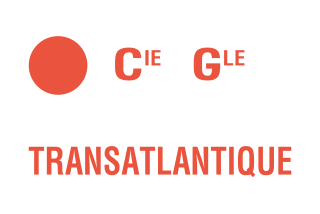
The Compagnie Générale Transatlantique, typically known overseas as the French Line, was a French shipping company. Established in 1855 by the brothers Émile and Issac Péreire under the name Compagnie Générale Maritime, the company was entrusted by the French government to transport mails to North America. In 1861, the name of the company was changed to Compagnie Générale Transatlantique. The company's first vessel, SS Washington, had its maiden voyage on 15 June 1864. After a period of trials and errors in the late 19th century, the company, under the direction of its presidents Jules Charles-Roux and John Dal Piaz, gained fame in the 1910s and 1930s with its prestigious ocean liners such as SS Paris, SS Île de France, and especially SS Normandie. Fragilized by the Second World War, the company regained its fame in 1962 with the famous SS France, which suffered major competition from air transport and was retired from service in 1974. In 1977, the company merged with the Compagnie des Messageries Maritimes to form the Compagnie Générale Maritime. Then, in 1996, the company Compagnie Générale Maritime merged to form the CMA CGM.

Messageries Maritimes was a French merchant shipping company. It was originally created in 1851 as Messageries nationales, later called Messageries impériales, and from 1871, Compagnie des messageries maritimes, casually known as "MesMar" or by its initials "MM". Its rectangular house flag, with the letters MM on a white background and red corners, was famous in shipping circles, especially on the Europe-Asia trade lanes. In 1977 it merged with Compagnie générale transatlantique to form Compagnie générale maritime. In 1996 CGM was privatized and sold to Compagnie Maritime d'Affrètement (CMA) to form CMA CGM.
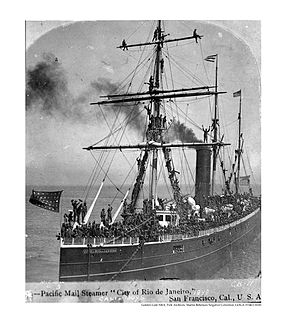
The SS City of Rio de Janeiro was an iron-hulled steam-powered passenger ship, launched in 1878, which sailed between San Francisco and various Asian Pacific ports. On 22 February 1901, the vessel sank after striking a submerged reef at the entry to San Francisco Bay while inward bound from Hong Kong. Of the approximately 220 passengers and crew on board, fewer than 85 people survived the sinking, while 135 others were killed in the catastrophe. The wreck lies in 287 feet (87 m) of water just off the Golden Gate and is listed in the National Register of Historic Places as nationally significant.
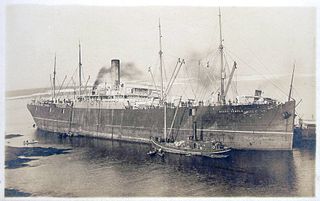
Mount Temple was a passenger cargo steamship built in 1901 by Armstrong Whitworth & Co. of Newcastle for Elder, Dempster Shipping of Liverpool to operate as part of their Beaver Line. The ship was shortly afterwards acquired by Canadian Pacific Lines and was one of the first vessels to respond to the distress signals of the RMS Titanic in 1912.
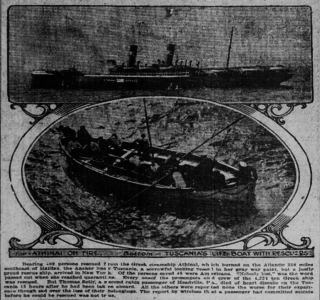
SS Athinai was a Greek transatlantic steamer that burned and sank on 19 September 1915.

SS La Touraine was an ocean liner that sailed for the Compagnie Générale Transatlantique from the 1890s to the 1920s. Built in France in 1891, she was primarily employed in transatlantic service on the North Atlantic. The liner was scrapped in Dunkirk in October 1923.

SS Zeeland was a British and Belgian ocean liner of the International Mercantile Marine Co. (IMM). She was a sister ship to Vaderland and a near sister ship to Kroonland and Finland of the same company. Although her name was Dutch, it was changed during World War I to the less German-sounding SS Northland. She served for a time as a British troop ship under the name HMT Northland. Reverting to Zeeland after the war, the ship was renamed SS Minnesota late in her career. Zeeland sailed primarily for IMM's Red Star Line for most of her early career, but also sailed under charter for the White Star Line, the International Navigation Company, the American Line, and the Atlantic Transport Line, all IMM subsidiary lines. The pursers safe survived the scrapyard at Inverkeithing and after residing in a wardrobe for 80 years is currently on display in a local private home.

SS La Bretagne was an ocean liner that sailed for the Compagnie Générale Transatlantique (CGT) from her launch in 1886 to 1912, sailing primarily in transatlantic service on the North Atlantic. Sold to Compagnie de Navigation Sud-Atlantique in 1912, she sailed for that company under her original name and, later, as SS Alesia on France–South America routes. The liner was sold for scrapping in the Netherlands in December 1923, but was lost while being towed.

SS Edward Luckenbach was the first of five new cargo ships to be built for the Luckenbach Steamship Company by Fore River Shipbuilding Corporation. The ship was launched in September 1916, delivered in November and briefly operated as such before being requisitioned for World War I service. The ship was one of the cargo vessels in the first large convoy transporting U.S. Army forces to France. After that convoy the ship served as a U.S. Army Chartered Transport (USACT) until converted by the Army to a troop ship and turned over to the Navy a few months before the war's end. The Navy commissioned the ship as USS Edward Luckenbach assigning the miscellaneous identification number ID-1662 in August 1918. The transport made one wartime voyage with continued voyages returning the Army to the U.S. until August 1919.
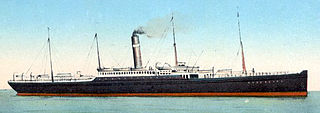
SS Merion was an ocean liner built in 1902 for the American Line, a subsidiary line of the International Mercantile Marine (IMM). She also sailed for the Red Star Line and the Dominion Line—both subsidiary lines of IMM—during her passenger career. After the outbreak of World War I she was bought by the British Admiralty and converted to serve as a decoy resembling the Royal Navy battlecruiser HMS Tiger. In May 1915, while posing as Tiger in the Aegean Sea, Merion was sunk by the German submarine SM UB-8.

SS De Grasse was an ocean liner built in 1921 by Cammell Laird, Birkenhead, United Kingdom for the Compagnie Generale Transatlantique, and launched in February 1924. In August 1924 The De Grasse set sail no her maiden voyage on the Le Havre to New York route. After the fall of France to Nazi germany, the ship was use as a floating barracks ship. Sunk at Bordeaux, France, during the German retreat, she was refloated, repaired and put back into service. Over the years and shipowners, she became the Empress of Australia and then Venezuela. The vessel ran aground off Cannes, France, in 1962 and was scrapped at La Spezia, Italy.

SS Utopia was a transatlantic passenger steamship built in 1874 by Robert Duncan & Co of Glasgow. From 1874 to 1882 she operated on Anchor Line routes from Glasgow to New York City, from Glasgow to Bombay and from London to New York City. After 1882 she carried Italian immigrants to the United States.
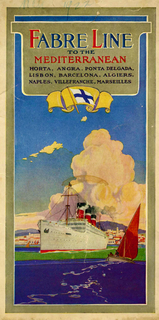
The Fabre Line or Compagnie Francaise de Navigation a Vapeur Cyprien Fabre & Compagnie was a French shipping line formed in 1881 by Cyprian Fabre. It began operating a small fleet of sailing ships in 1865. Its ports of call included New York, NY; Providence, Rhode Island; Boston, MA; Ponta Delgada, Madeira, and Lisbon, Portugal; Piraeus, Salonica, and Athens, Greece; Algiers, Morocco; Beirut, Lebanon; Naples & Palermo, Italy; Alexandria, Egypt; Jaffa and Haifa, Palestine; Constantinople, Turkey; and Monaco and Marseilles, France.

The Compagnie Fraissinet, a Marseilles-based shipping line, played an important role in trade and immigration flows in the Mediterranean, Black Sea, Western Africa and Latin America. The Compagnie Fraissinet added Northern America to its routes after a merger with the Compagnie Française de Navigation à Vapeur Cyprien Fabre & Cie. The Compagnie Fraissinet operated for close to 150 years through two World Wars, several revolutions, and the colonization and decolonization periods. The Fraissinet family started divesting from shipping activities in the 60s to concentrate on aviation and media. Fraissinet lowered its flag in 1968, the tanker Alfred-Fraissinet being the last ship of the company. Fabre kept on operating until 1979.

SS Bulgaria was a passenger-cargo steamship built in 1898 for the Hamburg American Line ("Hapag"). During World War I, she operated as a United States Army animal and cargo ship under the names USAT Hercules and USAT Philippines, and after the war was converted into the troop transport USS Philippines (ID-1677).

Monterey was a cargo schooner-rigged steamer built in 1897 by the Palmer's Ship Building & Iron Co of Jarrow for Elder, Dempster & Co. of Liverpool to serve on their cross-Atlantic routes.

SS Lamoricière was a French passenger liner operated by the Compagnie Générale Transatlantique. It was named after the French General Louis Juchault de Lamoricière.
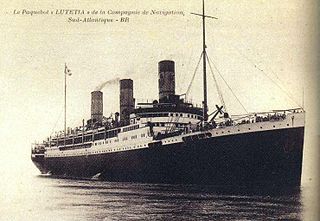
SS Lutetia was a steam ocean liner of the Compagnie de Navigation Sud-Atlantique. She was completed in 1913. Lutetia was the Roman city on the site of what is now Paris.
Anglo-African was a steam cargo ship built in 1900 by the Short Brothers of Sunderland for Lawther, Latta & Co. of London with intention of operating on their Australian routes. The vessel operated mostly on South America to North America route during her career and was wrecked on one of her regular voyages in January 1909.



















